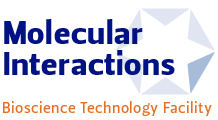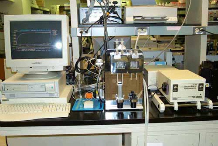Rapid reaction kinetics (Stopped-Flow)
Many chemical and biochemical processes take place too fast for convenient observation in a standard spectrophotometer. Sometimes this can be circumvented by choice of conditions, but for reactions that occur in 0.01 - 100 second timescales, stopped flow methods are very useful.
To study fast reactions like this it is necessary to mix the reactants quickly and effectively, then observe a spectroscopic change in the mixture as soon as possible after the mixing. This is done by holding the reactants in two syringe reservoirs which can be driven by a pneumatic ram or motors. At the start of a run the solutions pass through a mixer then a closely situated observation cell into another syringe called the stop syringe. The reacting mixture passes from the mixer to the observation cell in less then a millisecond. However, when the stop syringe fills up, the flow has to stop, and so the material in the observation cell is no longer freshly mixed and starts to age. There is an electrical contact on the stop syringe to trigger the start of measurements. The observation cell is made of quartz, and is arranged so that changes in absorbance or fluorescence at can be measured at visible or ultraviolet wavelengths.
Applications
Some applications:
- Protein-protein binding: many proteins contain tryptophan residues whose fluorescence changes between bound and unbound states. Stopped flow experiments can provide data on association rates for binding and hence on binding constants.
- Burst phase enzyme kinetics: some enzyme mechanisms involve intermediates which can only be observed transiently during the initial phases of the reaction.
Facilities
Applied Photophysics SX18MV with ProData PC upgrade. This is an industry standard system which has recently been upgraded with all new electronic subsystems and Windows PC interface. The hardware is a pneumatically operated syringe system capable of 1:1 and asymmetric mixing and with two additional syringes for sequential mixing experiments. The system uses a standard xenon arc lamp for UV and visible wavelengths and is capable of absorption and fluorescence emission measurements over 2 mm or 10 mm path length. The working parts are thermostatted by a recirculating water bath.
Accessories
A set of long-pass cut off filters from 320 to 600 nm for fluorescence work is available, as is a second monochromator which may be used in fluorescence experiments or for reduction of stray light in absorbance mode. We also have a PDA1 photodiode array which acquires an entire absorption spectrum simultaneously and is useful for study of reaction intermediates.
Samples
Before starting stopped-flow experiments it is advisable to establish by conventional spectrophotometry or fluorometry that a significant change in absorbance occurs as a consequence of the reaction. This will help define optimum wavelengths and conditions. Reaction rates are generally concentration dependent, but so is signal amplitude, hence conditions must be chosen with care. Solutions should be filtered to remove particles.
Links
- Applied Photophysics Ltd, manufacturer of Stopped flow, Laser Flash and Circular Dichroism spectrometers.


